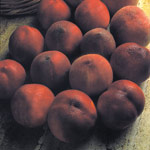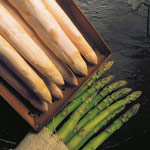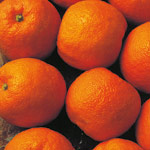products / stone fruits
When we speak of “ Stone Fruit” we refer to those fruits from the “Prunus” class of plants which belong to the Rosaciae family.
The fruit of the “Prunus” class is a a drupe with a wood-like endocarp (stone), containing a seed and a fleshy mesocarp (the edible part of these fruits). The most representative cultivated species of the “Prunus” genus are: “Prunus Persica” (peach and nectrine), “Prunus domestica” (European plum), “Prunus salicina” (Japanese plum) and “Prunus armeniaca” (apricot).
They are flavourful and refreshing fruits, an integral part of a balanced diet because of all the vitamins and minerals they possess; the high fibre content makes them very filling and therefore recommendable for weight loss diets, and it also serves as a mild laxative, especially in plums. They contain various substances with antioxidant properties that protect us from free radicals (free radicals cause some aging processes and illnesses like cancer).
All these aspects along with the great diversity of tastes and aromas that we find make this group of fruits many people’s favourites. Their nutritional components make them ideal for all age groups: children, young people, adults, athletes, pregnant women or those breast feeding, and senior citizens.
CULTIVATION
The cultivation of these stone fruits begins with the selection of the varieties to be cultivated. Depending on the variety selected, the soil, the climate and the cultural techniques to be taken into account, the support for the graft is selected.
The plants are placed in rows 5 to 7 metres apart, while the distance between the plants in each row is usually between 2 and 4.5 metres.
During the first cultivating years, the plants produce little or nothing; full production is reached after the fourth year for the peach / nectarine and after the fifth or sixth year for plums and apricots.
Starting during the very first years of cultivation, the plant must undergo pruning for shape which allows it to attain a proper structure able to withstand the weight of the crops, facilitates gathering and thinning out and admits sufficient amounts of light and air to contribute to the plant’s well-being…
Once the plant has begun to produce, it is necessary to carry out an annual pruning both during the foliage season (green pruning) and off-season.
From the first crops on, an intense thinning out of the fruit must be carried out (especially with peaches / nectarines) to get top quality fruit. This thinning out must be done by hand, and always before what is known as “the stone hardening stage”. In the case of the peach/nectarine, this is one of the steps that most increases the cost of the crop.
The fruit is gathered manually and in various stages, the fruit picked as it ripens to just the right degree.
Stone fruits are one of the crops that needs the most hand labour per unit of surface. In Andalucia in the last 20 years it has been a crop that has greatly benefited the economic development of the region, contributing to a large degree to the lower agrarian unemployment rates.
In all of our plantations we use sprinkling systems located to make the most of our water resources for irrigation with maximum efficiency; furthermore, we use Integrated Production techniques. All of this is done in the framework of the company’s clear commitment to protecting the environment.
Nutritional properties of stone fruits
| Quantity per 100 g of edible portion (average contents) | Apricot | Peach | Plums |
| Energy (Kcal) | 39,73 | 37,05 | 45,00 |
| Protein (g) | 0,80 | 0,60 | 0,60 |
| Fat (g) | 0,10 | 0,10 | 0,15 |
| Cholesterole (mg) | 0,00 | 0,00 | 0,00 |
| Carbohydrates (g) | 6,90 | 9,00 | 11,00 |
| Fiber (mg) | 1,80 | 1,40 | 2,10 |
| Calcium (mg) | 12,00 | 8,00 | 14,00 |
| Iron (mg) | 0,50 | 0,40 | 0,40 |
| Iodine (µg) | - | 3,00 | Tr |
| Magnesium (mg) | 5,00 | 9,00 | 8,00 |
| Zinc (mg) | 0,20 | 0,08 | Tr |
| Sodium (mg) | 3,00 | 1,00 | 3,00 |
| Potassium (mg) | 88,00 | 140,00 | 190,00 |
| Phosphorus (mg) | 14,00 | 22,00 | 19,00 |
| Thiamine (B1) (mg) | 0,03 | 0,03 | 0,07 |
| Riboflavine (B2) (mg) | 0,03 | 0,05 | 0,05 |
| Piridoxine (B6) (mg) | 0,07 | 0,02 | 0,05 |
| Vitamin B12 (µg) | 0,00 | 0,00 | 0,00 |
| Ascorbic Acid (C) (mg) | 7,00 | 8,00 | 3,00 |
| Niacine (mg eq. niacine) | 0,60 | 0,70 | 0,50 |
| Vitamin A (µg Eq. retinol) | 27,00 | 17,00 | 21,00 |
| Vitamin D (µg) | 0,00 | 0,00 | 0,00 |
Stone fruits contain a wide range of vitamins, among which we can highlight beta carotene, which is found in greater proportions in yellow-coloured varieties.
Beta carotene (or pro vitamin A) is transformed into Vitamin A in our organism, and is essential for good healthy skin, eyesight, hair, mucous passages, bones and a well-functioning immunological system. Furthermore its antioxidant action protects against free radicals and the aging of cells, reducing the risk of cardiovascular and degenerative diseases and cancer.
The reddish hue that appears in the pulp of some varieties is due to pigments called antocianos (pigments that also act as antioxidants and antiseptics). Stone fruits are also rich in potassium, which grants them diuretic properties, and are especially recommended in dietetic regimes for different cardiovascular diseases like high blood pressure and those associated with fluid retention. They are also good at replenishing this mineral when it is sometimes eliminated through the use of diuretics.
The wealth of fibre in these fruits also helps them alleviate mild constipation problems and control glucemic levels (the levels of sugar in the blood), as well as lower cholesterol levels in the blood. Plums, for example, along with fibre also contain sorbitol (a type of sugar) and hifroxiphenilxantine derivatives, which are substances that stimulate the colon muscles, which is why they have been used traditionally as laxatives for constipation.
In FOASAT we choose from a wide array of existing varieties for our crops, not only those that best adapt to our producing areas, but also those we deem to have the best organoleptic qualities. Among these, we can mention some for yellow pulped nectarines: Red lis, Zincal-5, Zincal-15, Morena, Fantasía, Spring bright. For peaches with yellow flesh: Candor, Candora, Bravo crest, Sun crest, Prince crest… For nectarines with white flesh: Silver, Early silvery, Belle rose, Silvery…. For white fleshed peaches: Robin, Bravo white, Show Star…. For plums: Red beauty, Black beauty, Royal garnet, Black star, Black gold, Santa rosa, King rose, Fortuna, Sun gold…. For apricots: Kov…



